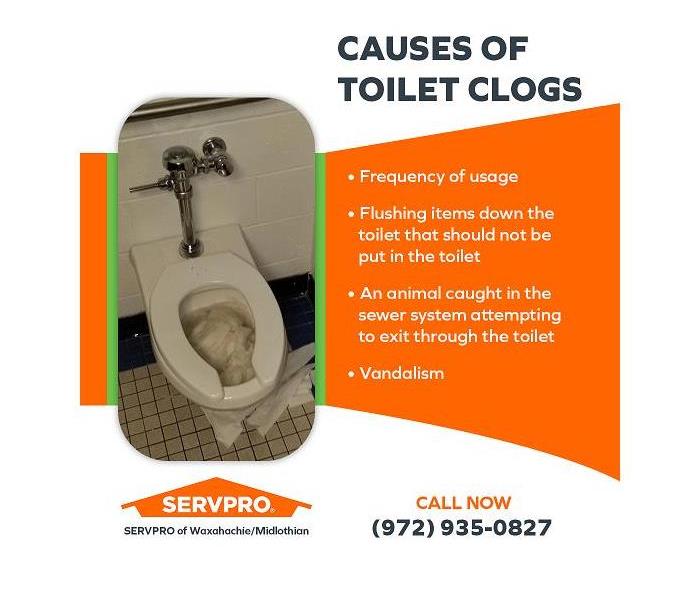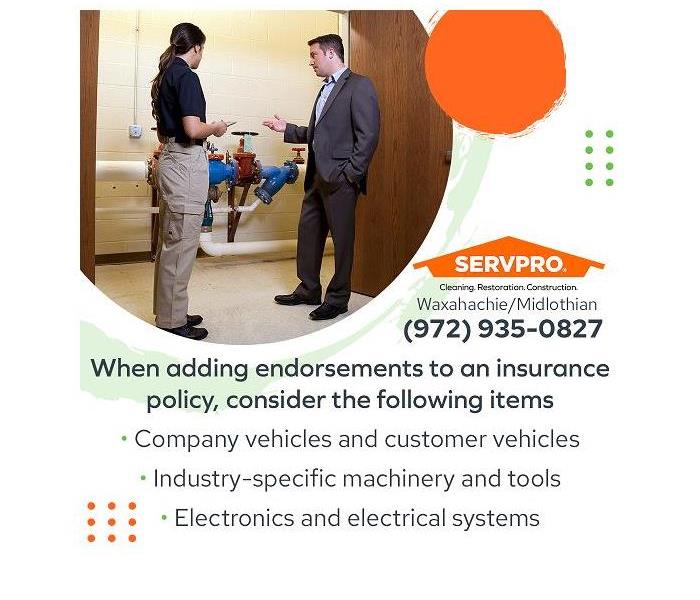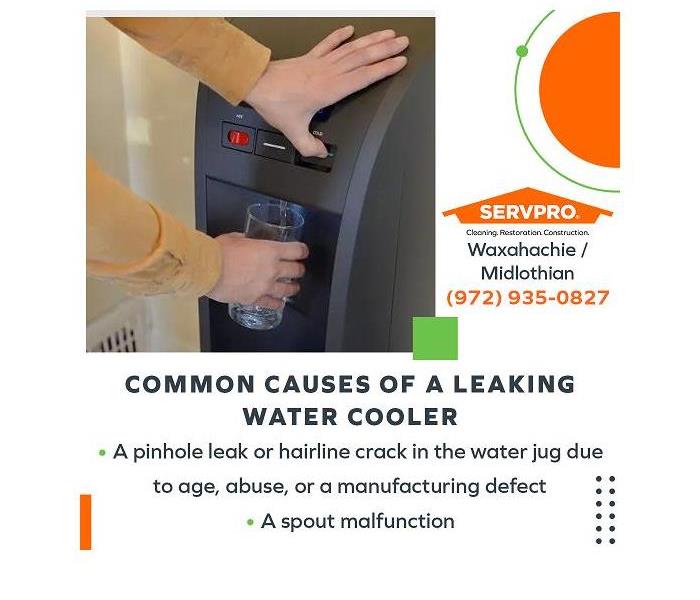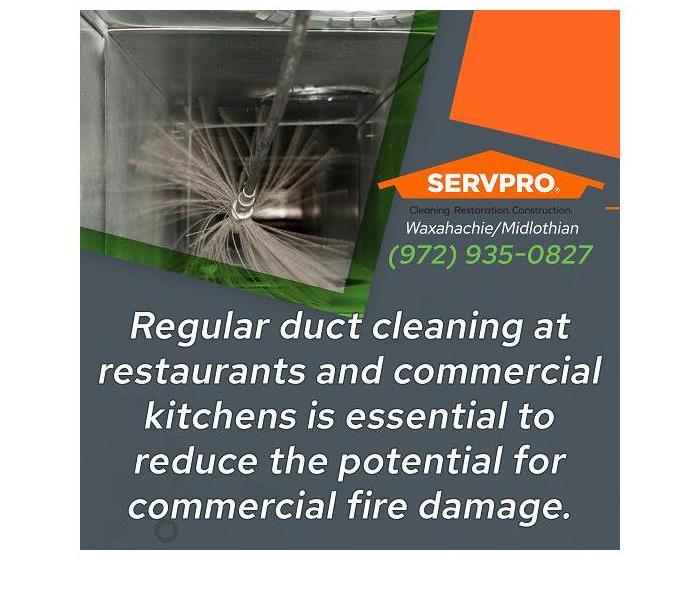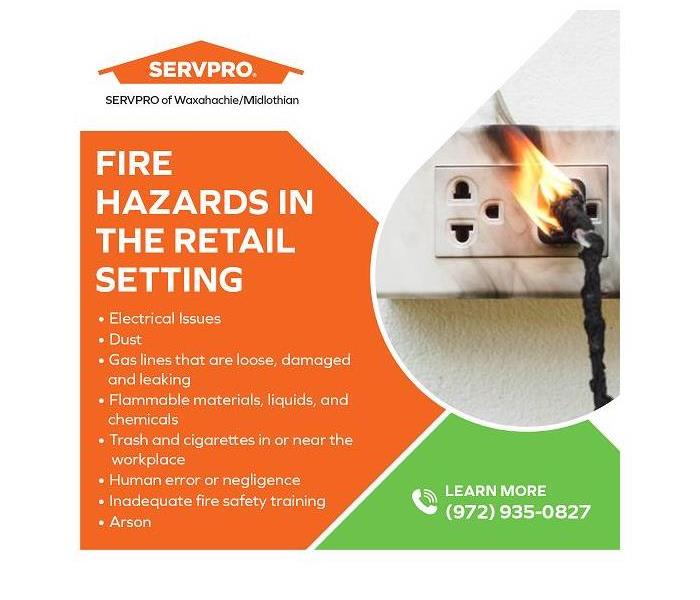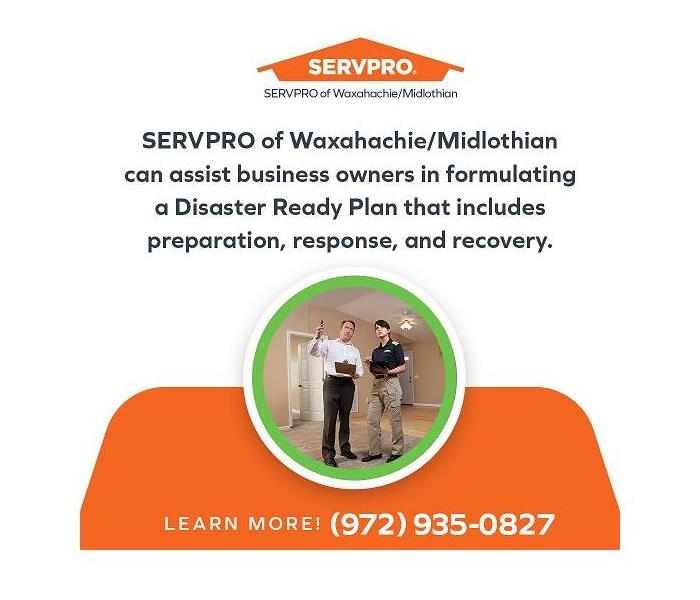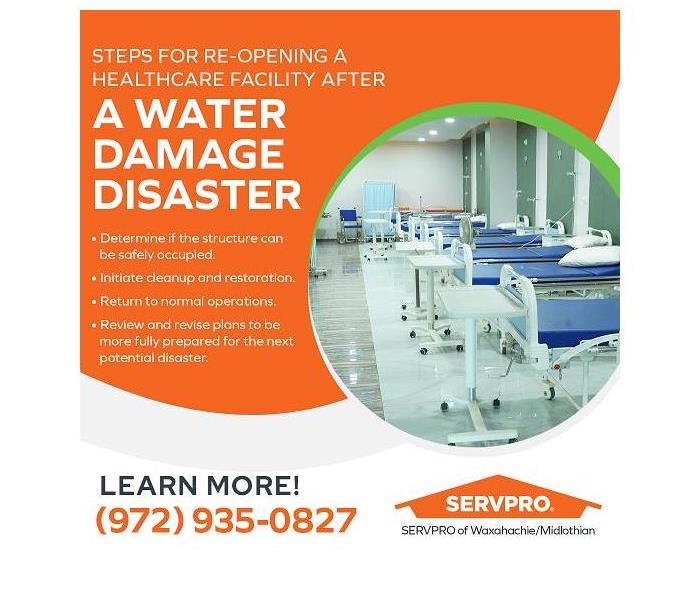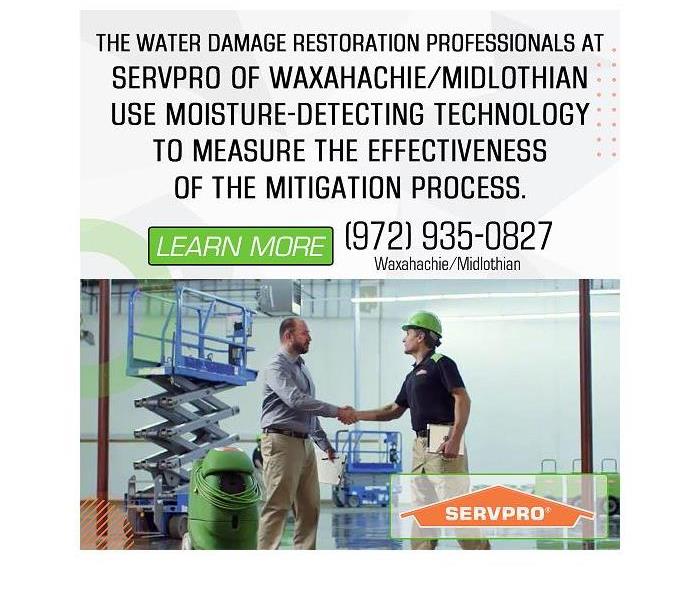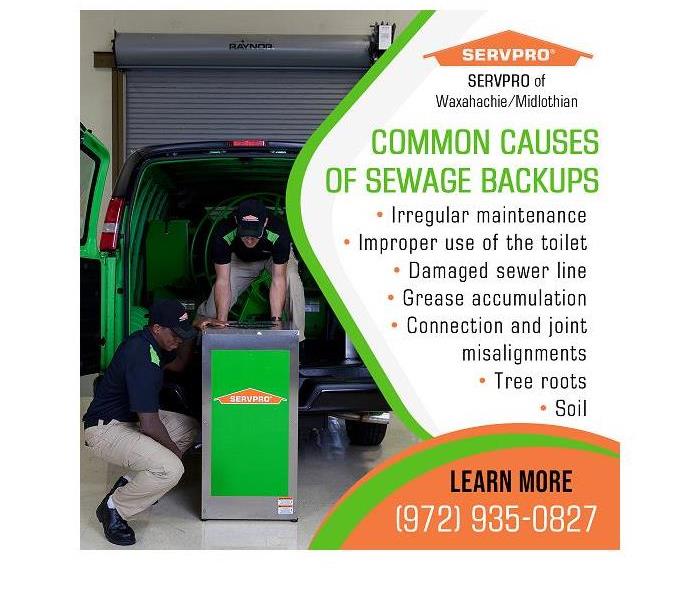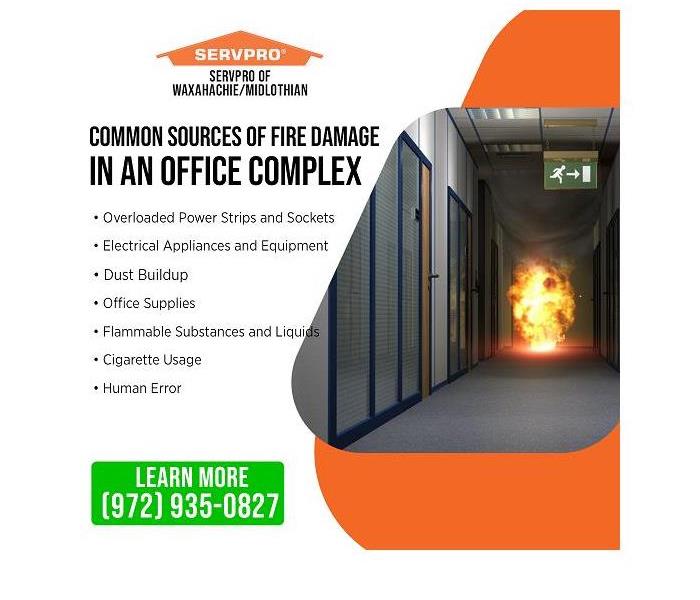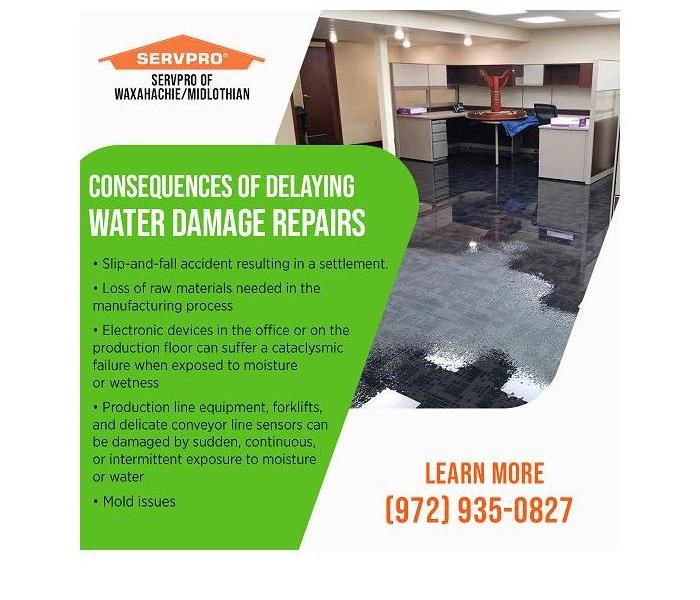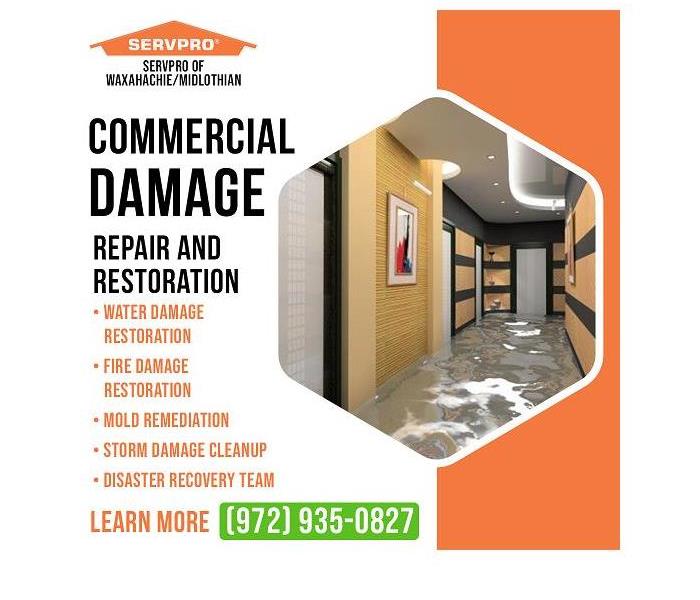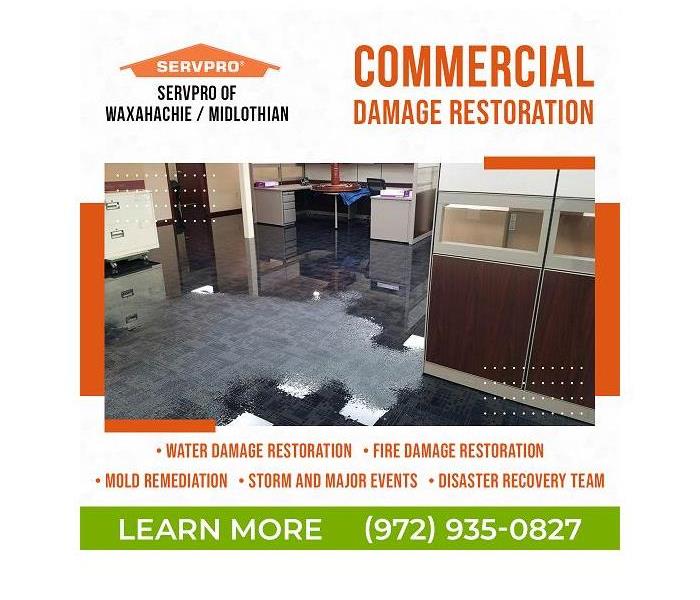Recent Commercial Posts
Water Removal and Cleanup Services for Water Damage Caused by Commercial Plumbing Issues
2/8/2023 (Permalink)
Blog Summary: SERVPRO of Waxahachie/Midlothian sheds light on common plumbing issues at commercial facilities. These plumbing issues can damage customer perception and cut into profits.
SERVPRO® of Waxahachie/Midlothian specializes in water removal, cleanup, and restoration. When raw sewage is involved in a water damage disaster, a thorough cleanup is crucial if the site is to be made sanitary and safe.
Any disruption of a business’s revenue cycle negatively impacts its profitability. Common causes of business interruptions may include:
- A major pandemic with widespread shutdowns, layoffs, and closings
- Disruptions in the international supply chain
- Worker shortages
- Travel restrictions
- Natural disasters such as hurricanes, tornadoes, and the February 2021 arctic blast
- Water damage from natural and man-made causes
Any one of these challenges has the potential to shut down a small business. Recovery often requires a change in the economic climate or other factors beyond the control of the business owner.
Business owners, property owners, and facilities managers in Venus, TX, are vested in keeping their commercial buildings attractive, comfortable, safe, clean, and sanitary. The emphasis is on ‘clean’ and ‘sanitary.’ The recent pandemic has heightened national awareness of the necessity of keeping the office, shop, manufacturing unit, restaurant, retail outlet, church, school, or fitness center as pathogen-free as possible without endangering the health of the occupants with surface and airborne cleaning, disinfecting, and sanitizing chemicals. An area of concern often overlooked in the commercial and professional setting includes plumbing, septic, and sewage issues.
Employees, patrons, patients, and tenants exert tremendous pressure on a commercial plumbing system, and this continuous pressure creates new problems and amplifies any existing plumbing issues. A sewage backup in a professional office building, a school, or a daycare with a large clientele and multiple bathrooms on each floor can escalate into a catastrophe of epic proportions.
Commercial plumbing issues tend to be more expensive to repair and clean up. Multiple bathrooms and multiple floors expand the spillage zone, increasing the cost of cleanup. Work slowdowns or stoppages cut deeply into daily and monthly revenues. In fact, the loss of business may far exceed the actual costs to remedy the situation in the building.
The business owner, facilities supervisor, and property management company must keep a vigilant eye on the buildings under their care. Listed below are some of the most common plumbing issues that arise in commercial facilities.
A clogged toilet
A toilet clog is a common occurrence in the commercial world. Causes of toilet clogs include the following:
- Frequency of usage
- Flushing unnecessary items down the toilet
- An animal (snake, rat, frog, or squirrel) caught in the sewer system attempting to exit through the toilet
- Vandalism
If initial efforts with a plunger fail, contact a licensed, bonded, insured plumber to remove the clog or make any necessary repairs. Proper maintenance and scheduled cleaning will spot problems in their infancy when solutions are quick, easy, and relatively inexpensive. Delays can have the undesired effect of compounding the clog, increasing spillage, and offending the sensibilities of customers and employees.
If the janitorial staff is unable to handle an extensive spillage, bring in a professional property damage cleanup company to remove the contaminated water with heavy-duty wet/dry vacuums, reduce the moisture levels, and clean, disinfect, sanitize, and deodorize the affected areas. In a multi-story building, delays in removing the black water may allow the water to seep through the flooring and contaminate the commercial space under the toilets. Sewage is messy, smelly, and unsafe for everyone in the building. If the HVAC system is contaminated, the entire building may be negatively affected.
Drain clogs
A drain clog may not be as disruptive and annoying as a toilet clog. Items that can stop up the sink include paper towels, grease, oil, chemicals, food, or dirt and grime. If a customer, client, or employee accidentally leaves the water running, a water damage disaster could result. At seven gallons of water per minute, a faucet left running into a clogged sink can spill thousands of gallons of water per day into a commercial facility. If the water damage disaster is on an upper floor in a multi-story building, the entire operation could be shut down for days while the building is undergoing cleanup and restoration.
Do not let a sewage backup from a clogged toilet or an extensive water damage disaster from a water release shut the doors of the business and turn off profits. SERVPRO of Waxahachie/Midlothian can arrive on the scene in about an hour. If the damage is extensive, the SERVPRO franchise family can scale to any size disaster. Available 24/7, 365 days a year, including weekends, the team of IICRC-certified professionals provides a rapid response and quick cleanup to get the wheels of commerce back in motion. The SERVPRO staff can also effectively handle the insurance claims process from end to end.
For more information about Venus, TX, water removal services, contact SERVPRO of Waxahachie/Midlothian by phone at (972) 935-0827 or email at acarey@SERVPRO10932.com.
Helping Businesses in the Automotive Repair Industry Navigate Coverage for Water and Flood Damage
11/8/2022 (Permalink)
Blog Summary: SERVPRO® of Waxahachie/Midlothian outlines strategies for securing insurance coverage that sufficiently safeguards an auto body shop.
The commercial water damage restoration professionals at SERVPRO of Waxahachie/Midlothian understand the pressures that water and flood damage can put on a business, including auto body shops. Damaged equipment, lost time, and lost profits can take a toll on an automotive repair business, potentially causing it to close down. When water damage occurs, comprehensive insurance coverage can make the difference between a rapid recovery or a sudden shuttering of operations.
Determining the business’s flood zone
Water damage caused by storm-related flooding is not covered in the same way as water damage from a burst pipe. If the auto body shop is located in a flood zone or in an area that commonly experiences water damage from floodwaters, the owner will need to acquire a separate flood insurance policy to ensure that the business is protected against the costs of flood damage restoration. The National Flood Insurance Program (NFIP) “provides flood insurance to property owners, renters, and businesses, and having this coverage helps them recover faster when floodwaters recede.”
Insuring equipment for an automotive repair business
When adding endorsements to an insurance policy, consider the following items for which coverage could be advantageous:
Company vehicles and customer vehicles
Multiple forms of vehicle insurance will likely be needed for an auto body shop. The first type of insurance is for vehicles owned and used by the company. A comprehensive commercial auto insurance policy will provide broad coverage that includes protection from events other than automobile collisions. The second type of insurance, called garage keeper’s liability insurance, protects customers’ vehicles that are kept on-site for tune-ups or repairs.
Industry-specific machinery and tools
The policy limit is the cap on what insurance will cover when it comes to damaged property and equipment. If it is anticipated that the cost of machinery used in the auto body shop is higher than the policy limit, the business owner should consider increasing coverage or obtaining separate deductibles for each individual piece of equipment. Sufficient coverage will enable the auto repair business to replace its essential machinery and tools, such as hydraulic vehicle lifts, air compressors, engine hoists, floor jacks, transmission jacks, oil caddies, battery chargers, brake lathes, strut compressors, air conditioning recovery machines, and hydraulic presses.
Electronics and electrical systems
Water is highly destructive when it comes into contact with electronics, and computers, security cameras, shop lights, and other equipment are vulnerable to being destroyed by flood damage. In addition to replacing damaged electronics, insurance may also pay to rewire water-damaged areas of the facility.
Other situations to consider
Building code requirements
Often, a water damage disaster involves structural damage that requires reconstruction services in addition to water damage cleanup and restoration services. However, when reconstruction is needed, complexities arise. A Texas insurance claim attorney explains, “Once a structure has been damaged, the law requires that new construction will have to conform to current building codes. If your location was built over a decade ago, increased costs may include widening doorways or rewiring circuits—costs that are not covered under standard policies. Ordinance and law coverage can provide the payment you need for plumbing upgrades, increased costs of construction, and the expense of meeting new building regulations.”
In severe cases of water damage, the rebuilding process could take an extended period of time: weeks or even months. If the auto body shop has to temporarily shut down while repairs are made, the owner loses much-needed income. Business interruption insurance helps mitigate that loss. According to insurance provider Nationwide, “business interruption insurance helps you pay bills, replace the lost income, and cover payroll when a covered event forces your business to close temporarily.”
Catastrophic property damage
Unfortunately, some water or flood damage events are so severe that the most cost-effective response to the disaster is for the auto body shop to close down permanently. However, if the business owner invested in total loss coverage, compensation would cover the value of the unsalvageable building and equipment, enabling the owner to have a fresh start.
Choosing a restoration company that handles the insurance claims process
At SERVPRO of Waxahachie/Midlothian, the team works with the client’s insurance company and helps manage the paperwork in order to provide a stress-free insurance claims process. SERVPRO staff ensures that the insurance company is informed about which items are salvageable and which items will need to be replaced. Also, technicians deliver a detailed estimate that is thoroughly documented and includes both images and video. This estimate prevents surprises and is a valuable asset in the claims process.
To learn more about commercial flood damage restoration, call SERVPRO® of Waxahachie/Midlothian at (972) 935-0827. The office can also be reached by email at acarey@SERVPRO10932.com.
Six Steps to Repair a Water Cooler Leak and Deal with the Water Damage in the Office Environment
9/8/2022 (Permalink)
Blog Summary: SERVPRO of Waxahachie/Midlothian highlights ways to diagnose and repair a water cooler leak at the office.
SERVPRO® of Waxahachie/Midlothian can handle any size commercial water damage disaster, whether the water damage is a 5-gallon water leak at the water cooler or a 5,000-gallon water leak from a water fountain over a long holiday weekend.
The company water cooler serves many positive purposes. The filtered water it provides makes for a great pot of coffee for the management team after several hours of strategizing. Discussions around the water cooler foster comradery and build company morale. The unit is also good at what it was designed to do: dispense cool, refreshing water to thirsty employees and visitors.
If the water cooler is out of commission or springs a leak, the results are not only inconvenient but can also be disastrous. A water cooler can accommodate a five- or ten-gallon water bottle. Should the unit spring a leak, water damage is limited to whatever amount of water remains in the bottle and spills onto the floor.
Reducing the risk of a water fountain water damage disaster
On the other hand, a water fountain connected to a water line has the potential to continuously release one-half gallon of water per minute as long as the water is on. Over a typical weekend, as much as 2,000 gallons can spill onto the floor. If the facility is multi-story and the leaking water fountain is on an upper floor, the water damage could be catastrophic.
Two thousand gallons is much more than the four gallons from the water bottle on the water cooler. The water leak from the water cooler may not need anything more than a mop and bucket to remediate. The water fountain spill may require heavy-duty pumps, wet-dry vacuums, rapid-spin fans, and commercial dehumidifiers to remediate. Installing a water leak detection device on a water fountain provides an effective way to prevent a severe water damage disaster in a commercial setting.
Diagnosing a water cooler leak
Usually, a water cooler is leaking due to a crack or hole in the bottle. Also, pressure changes may be the reason for the water release. Here are some simple steps to identify the source of the leak and repair the device.
Common causes of a leaking water cooler
Some of the common causes of a leaking water cooler may include:
- A pinhole leak or hairline crack in the water jug due to age, abuse, or a manufacturing defect
Typically, the cooler unit is not the problem.
- A spout malfunction
The spout mechanism may be damaged from stress or from an impact. A valve in the spout mechanism may be failing due to age or wear.
Steps to repair the leak
Once the leak is diagnosed, here are some steps to take to repair the device.
- Locate the physical owner’s manual or download a version from the web. This manual may contain a parts list. If not, a parts list can be obtained from the manufacturer, probably from the same website from which the owner’s manual was obtained.
- Tools needed for the repairs include a screwdriver, pliers, wrenches, and a flashlight.
- Have a towel or two available if the water inside the unit spills out.
How to repair a leaking water cooler in six steps
Step #1: Shut off the water supply.
This step may involve making sure the faucet or spigot is snugly turned off or shutting off the water if the cooler is connected to a permanent supply line. The unit may have an inline shutoff valve which makes this step very simple.
Step #2: Mark the water level.
Mark the water level on the bottle with a piece of tape or a non-permanent marker. The speed of the water loss may help reveal the cause of the leak. A very slow leak may involve a defective or damaged seal, and a fast leak will leave a trail to its origin. In any case, put down towels to absorb any water and thus, prevent unnecessary water damage.
Step #3: Carefully remove the bottle and monitor its contents.
Remove the bottle from the cooler. Place it in a large sink or take it outside. The goal is to prohibit any further water damage. If the water level in the bottle drops, the leak is in the bottle. If the water cooler unit continues to release water with the bottle having been removed, the leak is in the internal components of the device. Place a cup or pan under the spigot to catch any dripping water. The goal is to prevent water damage and avoid any slip-and-fall hazards.
Step #4: Check the reservoir for a clog.
If the reservoir is clogged, water can back up and spill onto the floor, causing water damage and a slip-and-fall hazard.
Step #5: Check the spout and spigot for leaks.
If a crack or leak is discovered, then replace or repair the part.
Step #6: Replace the unit if it is beyond repair.
Sometimes the damage may be so severe that the best recourse is to simply replace the entire unit rather than risk a water damage disaster.
SERVPRO of Waxahachie/Midlothian can handle any size disaster, from a leaky water cooler and ten gallons of water on the office floor to several thousand gallons from a leaking water fountain over several floors. Crews are available 24/7, 365 days a year, including holidays.
For more information about Midlothian, TX, commercial water damage restoration and mold mitigation, contact SERVPRO of Waxahachie/Midlothian by phone at (972) 935-0827 or by email at acarey@SERVPRO10932.com.
How Frequently Should Midlothian, TX, Restaurants Have Their Ducts Cleaned to Avoid Fire Damage?
7/16/2022 (Permalink)
Blog Summary: SERVPRO of Waxahachie/Midlothian offers insight on scheduling inspections and cleaning of exhaust systems in restaurants and other commercial cooking operations such as senior centers, churches, day camps, and schools.
SERVPRO of Waxahachie/Midlothian explains how frequently restaurants should have their exhaust system and ducts cleaned to prevent fire damage. Regular duct cleaning at restaurants and commercial kitchens is essential to reduce the potential for commercial fire damage.
In the restaurant and food services industry, clean ducts are crucial for preventing fire damage. Every commercial kitchen should maintain clean ducts whether usage is high or low. Dirty, greasy ducts are a fire hazard. As time passes, even commercial kitchens that are used infrequently need attention.
Duct cleaning frequency is a vital component of a fire prevention strategy in a restaurant or commercial kitchen. Important questions that Midlothian, TX, restaurant owners or commercial kitchen managers should address are:
- How often should ducts be inspected?
- How often should the ducts be cleaned?
- Who should inspect and clean the ducts?
Inspection Frequency
Activities in commercial kitchens create fire hazards. Open flames and hot burners are numerous. Flammable liquids used in the cooking process raise the risk hazard of fire, and combustible materials such as the food being cooked, paper and cloth napkins, rags, and clothing are everywhere. If the fire and heat in the kitchen ever become uncontrolled, serious structural damage and personal injury to the staff and customers can result.
Inspections are the key to a safe kitchen. Frequent inspections monitor a situation that only worsens over time. Key indicators will signal the need to schedule a cleaning. Vigilance is the key ingredient to a safe kitchen. How frequently should the exhaust system be inspected? The answer is largely determined by the volume of cooking that takes place in the commercial cooking operation. The higher the cooking volume, the more frequently the system should be inspected. Higher usage yields greater grease and grime buildup. When inspections reveal that the conditions in the exhaust system need attention, a cleaning can be scheduled. Not every inspection will call for a cleaning. Cooking frequency may be reduced. The menu may have changed or shifted emphasis, resulting in decreased preparation of grease-producing foods. Inspections are still instrumental in determining when an exhaust system should be cleaned.
Cleaning Frequency
Restaurants and other commercial cooking operations that are active around the clock will require more frequent inspections and cleaning. Both inspections and cleaning should be conducted on a quarterly basis in cooking operations that are around the clock. As soon as an inspector determines that cleaning is needed, prompt action should be taken to make the exhaust system safe from fire hazards and compliant with any applicable regulatory code.
Commercial and institutional cooking operations that sustain a moderate cooking volume, such as only one meal a day, would require less frequent inspections and cleaning. Inspections and cleaning need only take place two or three times a year. The nature of the food being prepared may have a bearing on the cleaning schedule. A breakfast-only restaurant or a lunch-only short order diner with a heavy menu of fried and grilled items would need extra inspections and cleaning to remove the heavy grease buildup.
Light duty cooking operations that are only open seasonally should have the exhaust system cleaned annually. A commercial kitchen at a church may fall into this category. Food prep may consist of a weekly fellowship meal or an occasional breakfast, fish fry, or wild game dinner. Grease and grime buildup may not have reached the critical point of creating a fire hazard, but cleanliness and odor do become a factor when grease becomes rancid and begins to smell.
An inspection and cleaning schedule that reflects cooking volume, type of cooking equipment, and the typical menu can be determined by thoroughly cleaning a duct and then returning in thirty days to measure the accumulated grease. When in doubt, clean it out! Cleaner is always safer, especially when lowering the risk of fire damage is a factor in the inspection and cleaning equation.
Why Call SERVPRO When a Fire Damage Disaster Strikes
Locally owned and operated, SERVPRO of Waxahachie/Midlothian has been serving the area since 2000. Available 24/7, 365 days a year, the team of fire damage cleanup and damage restoration professionals provide a rapid response and a quick cleanup to get fire-damaged businesses up and running as soon as possible.
To learn more about Midlothian, TX, commercial fire damage restoration, contact the SERVPRO of Waxahachie/Midlothian office by email at acarey@SERVPRO10932.com or by phone at (972) 935-0827.
What Are Some Common Commercial Fire Damage Hazards in Retail Stores?
6/9/2022 (Permalink)
Blog Summary: SERVPRO of Waxahachie / Midlothian advises employers and employees to be aware of common fire risks in retail stores.
SERVPRO of Waxahachie / Midlothian understands the unique complexities associated with commercial water damage restoration. The size of the damaged structure, the potential risk hazards of volatile substances and water-reactive chemicals, and the need to resume normal business operations as quickly as possible require that the property damage restoration company have trained and experienced technicians, powerful equipment, cutting edge technologies, and the most advanced cleaning techniques to move the project along at a rapid pace.
Both small store-front retailers and national multi-site big-box retail stores are vulnerable to fire safety hazards. During daily business operations, the exercise of caution with obvious fire risks is easy. The unexpected fire hazards, however, present real danger. Many of these “hidden” fire hazards are in plain sight, especially in stores that offer a wide sales selection.
Risk Management of Potential Retail Fire Hazards
Potential fire hazards abound in a retail setting. Identification of the risks and the exercise of adequate risk management are crucial for the safety of employees, customers, inventory, and the structure. Two of the most common fire hazards are electrical issues and excessive dust.
Fire Hazard: Electrical Issues
Electrical fires are a leading cause of fire damage in a retail setting. Electrical hazards include damaged plugs, defective outlets, overloaded circuits, and loose wiring. A marked increase in the use of electronic devices, computers, appliances, and extension cords can overload an outlet, and the resulting heat can ignite nearby combustible materials.
Risk Management: Electrical Hazards
- Schedule and track a daily inspection of plugs, sockets, outlets, and extension cords. The MOD (“manager on duty”) can facilitate the activity. The business’ task management platform can be a useful tool to schedule, track, and archive any issues with images and video.
- Keep dust and debris to a minimum on the sales floor, in the back room, and in the warehouse.
- Inspect the electronics and appliance departments for overloaded circuits, faulty wiring, and damaged extension cords. Constant activity and heavy foot traffic make a retail floor space a dynamic area. Situations change from moment to moment. A piece of heavy equipment can damage an extension cord or outlet without the damage being noticed until a smoke alarm alerts the sales force and customers to a fire.
- Pay special attention to the use of extension cords. Extension cords are only a temporary solution. Install new receptacles to meet permanent needs. Never plug one or more power strips into a power strip. Daisy-chained power strips are extreme hazards and are prohibited.
- Resolve lighting issues such as burned-out bulbs and malfunctioning light fixtures. Switch to LED bulbs to reduce the likelihood of fire and to save energy.
- Have an electrical engineer periodically inspect the entire electrical system, from the panel box to the receptacle and what is plugged into it. Resolve any issues immediately.
- Unplug non-essential equipment and machinery when not in use or at the end of the day unless otherwise necessary.
- Keep the break room safe by implementing a fire safety plan for any cooking appliances in the kitchen area. Make sure appliances are turned off at the end of the day. Keep food wrappers, pizza boxes, paper napkins, and other flammables away from stove burners, hot plates, toasters, waffle irons, and other heat sources.
So much attention needs to be allotted to electrical fire hazards because the leading causes of fire in retail stores were caused by cooking, electric malfunctions, and heating.
Fire Hazard: Dust in Retail Stores
Dust is plentiful in the retail environment and is also a serious fire threat. Sources of dust include the HVAC system, corrugated boxes, merchandise, foot traffic, and nearby grading and construction generate dust that can ignite with only a spark and spread rapidly through a facility. Many retail outlets feature exposed ceilings, and exposed rafters and steel girders are dust magnets. If the dust ignites, the fire can travel along the steel girders at breakneck speeds, consuming the building in minutes.
Risk Management: Dust Hazards
To minimize the risk of a dust fire, keep the facility as dust-free as possible.
- Implement a daily departmental dusting policy.
- Clean exposed girders, ducting, conduit, and ceiling fans on a monthly or quarterly basis. A team of well-trained and thoroughly equipped employees might be able to handle this task. Consult with corporate management or the insurance company before having employees assume out-of-coverage risks that could expose the business to millions of dollars in accident claims payouts.
- Install heavy-duty extraction fans in areas where dust is excessive. These high-dust areas might need monthly cleaning.
Other Fire Hazards in the Retail Setting That Should Not Be Overlooked
Other fire hazards in a retail business setting that need attention and close management include:
- Gas lines that are loose, damaged and leaking
- Flammable materials, liquids, and chemicals
- Trash and cigarettes in or near the workplace
- Human error or negligence
- Inadequate fire safety training
- Arson
With all these hazards in the retail environment, a business should pre-qualify a property damage restoration company so that when a fire, smoke, or water damage disaster strikes, one call yields fast results. SERVPRO of Waxahachie / Midlothian is available to provide emergency services 24 hours a day, 365 days a year, including holidays. Rapid action reduces downtime and lost revenue.
Contact SERVPRO of Waxahachie/Midlothian for more details about commercial fire damage restoration and commercial water damage cleanup. The team can be reached by calling (972) 935-0827 or emailing acarey@SERVPRO10932.com
Should a Business Attempt a DIY Property Damage Cleanup Project?
4/12/2022 (Permalink)
Blog Summary: SERVPRO of Waxahachie/Midlothian highlights the dangers and inefficiency of a DIY property damage cleanup project in a commercial environment.
When a business suffers water damage that necessitates water removal, physical property is not the only thing affected. Normal business operations are disrupted or cease altogether. Retail sales are dramatically curtailed, and product flow churns to a halt as assembly lines grow silent. The provision of onsite client services is interrupted indefinitely. Revenue slows to a trickle while overhead explodes. Profits plunge while expenses skyrocket. Rapid water cleanup is a priority in order to restore normal business operations, resume provision of client services, regain sales momentum and return to a positive cash flow. Success hinges on a swift cleanup and recovery.
What to Do During and After the Water Damage Disaster
When a property damage disaster occurs at a Midlothian, TX, business, immediate steps must be taken. In the event of a fire, chemical spill, or personal injury, first responders should be immediately notified of the need for emergency services.
Step #1: Implement the formal Disaster Ready Plan if one is in place.
A comprehensive disaster readiness plan encompasses preparation, training, response, and recovery. Separate from but linked to the Disaster Ready Plan is the business continuity plan, which focuses on the continuance of a business in the context of catastrophic devastation. Catastrophes could include total loss of a facility, destruction of the means of production, massive data breach or data loss, supply chain collapse, or loss of a key person or persons.
Step #2: Stabilize the situation.
This step includes extinguishing a fire or shutting off the water, electricity, and natural gas. If necessary, roof damage should be tarped.
Step #3: Ensure the safety of the occupants.
Human life always takes priority over the facility, equipment, and product. If the situation is not stabilized, circumstances can escalate to a point where personal safety becomes a factor.
Step #4: Protect the structure and its contents.
During and after the disaster, employees will take the appropriate action to protect vital equipment, important documents, electronics, inventory, raw materials, and any toxic chemicals. Tarp or relocate anything of value to a safe location, and engage emergency backup systems, including data backup. Relocate hazardous materials to safety.
Step #5: Begin the cleanup and restoration process.
A rapid and thorough restoration project is essential for the success of the business. Business owners and senior management have two options. Employees can be enlisted to handle the task, or a property damage restoration company can be contracted to handle the cleanup and restoration.
Compelling Reasons to Choose a Restoration Professional
Two compelling reasons argue against utilizing payroll personnel to handle the cleanup and restoration: liability and inefficiency. When employees are tasked with duties outside the scope of their job description, the employer is exposed to liabilities that can have a greater financial impact than the property damage disaster.
Important Consideration: Liability
Employees may sustain physical injuries or trauma that leads to a loss time accident, a workers compensation claim, or litigation. These dangers include:
- Back, joint, or muscle injuries from heavy lifting or overexertion
- Slip-and-fall injuries
- Health effects arising from over exposure to heat
- Lacerations or puncture wounds
- Health issues or injuries arising from exposure to harmful particulate matter and toxins resulting from a fire or chemical spill
- Health concerns arising from exposure to raw sewage
- Stress and anxiety from working in a high-stress and dangerous environment
As a side note, employers may face legal pushback from unions and trade associations when employees engage in work activities beyond the range of their job description.
Important Consideration: Efficiency
Resumption of normal business operations is critical for a small business to survive a property damage disaster that interrupts the revenue cycle. Delays can be extremely costly for any business since time, the creation of goods and the delivery of services yield revenue.
Hardworking employees who lack knowledge, training, experience, the proper equipment, techniques, and cleaning products cannot possibly perform cleanup and restoration with the efficiency and thoroughness of a skilled, competent, well-equipped, and highly coordinated team of property damage restoration professionals.
The Benefits of Professional Cleaning and Restoration Services
SERVPRO of Waxahachie/Midlothian will assist business owners in formulating a Disaster Ready Plan that includes preparation, response, and recovery. The SERVPRO team provides a rapid response within an hour, 24/7, 365 days a year, including holidays. The team inspects and assesses the damage, and a detailed, documented estimate is provided to the client. In the meantime, mitigation and stabilization efforts are underway. The skilled, well-equipped, and highly coordinated crew work quickly to clean up and restore the disaster damage. Crews are equipped with the proper personal protective gear (PPG) and follow strict safety guidelines to protect themselves, others, and the property of the client. SERVPRO of Waxahachie/Midlothian is licensed, bonded, and insured.
The team at SERVPRO of Waxahachie/Midlothian can be reached by email at acarey@SERVPRO10932.com or by phone at (972) 935-0827.
The Importance of Water Damage Restoration Services for the Healthcare Industry
3/7/2022 (Permalink)
Blog Summary: SERVPRO of Waxahachie/Midlothian offers water removal and property damage restoration when healthcare facilities suffer a water damage disaster.
SERVPRO of Waxahachie/Midlothian understands the stress, anxiety, and frustration that administrators, doctors, nurses, and support staff experience when water damage necessitates water removal in a specialized commercial setting such as a hospital, nursing home, or other healthcare facilities. Storm damage to the roof can allow massive amounts of water to leak into the facility disrupting patient care, interrupting surgical procedures, and endangering the lives of staff and patients. With the passing of each minute, the scope and complexity of the disaster escalate to include more than bulk water removal and dehumidification.
Steps for Re-Opening a Healthcare Facility after a Water Damage Disaster
In a crisis or large-scale natural disaster, residents of the Midlothian, TX, community look to the local hospitals for emergency services, healthcare, and shelter. Sometimes severe weather, flooding, or other disasters interrupt the facility’s ability to provide services. This disaster may disrupt the provision of services for days or weeks. The initial removal of bulk water may not resolve all issues related to the water damage. Hospitals and other healthcare facilities may still need to address mold or mildew caused by leaks or flooding. These steps will help facility managers work through the challenges of reopening a healthcare facility following a major water damage incident.
Step #1: Determine if the structure can be safely occupied.
Severe weather such as a tornado, violent thunderstorm, or the remnants of a hurricane can undermine the structural integrity of the facility. The building must be evaluated for risk hazards prior to re-entry, and the assessment will seek to determine whether the structure is safe for occupancy.
Step #2: Initiate cleanup and restoration.
This step begins with the removal of bulk water, dehumidification, and applied structural drying. The immediate removal of any standing water will avoid secondary damage. Once areas are safe for traffic, technicians can clean, disinfect, and deodorize water-damaged items, floors, walls, and equipment. Repairs can begin. Potential contamination issues from mold, mildew, sewage backups, medical wastes, and chemical spills must also be identified and remediated.
Step #3: Return to normal operations.
The resumption of normal operations requires that the facility receive a final, thorough cleaning, sanitizing, and disinfecting to create a safe environment for staff and patients. Supplies must be restocked, and damaged or destroyed equipment must be repaired or replaced.
Step #4: Review and revise plans to be more fully prepared for the next potential disaster.
A property damage disaster is traumatic for everyone involved. A disaster in a hospital or healthcare facility highlights several needs:
- The need to have a customized Disaster Ready Plan that includes regular training and drills.
- The need to pre-qualify a property damage cleanup and restoration company.
The team of professionals must be competent to safely handle a disaster scene that involves a complex matrix of hazards, including contaminated water, medical wastes, chemical spills, and other biohazards. This company must be able to scale without delay to meet the full scope of the damage disaster. Emergency board-up and tarping, secure offsite storage facilities, electronics restoration, and document restoration must be components of the property damage restoration solution.
- The need to learn from the experience.
In the stressful chaos of a natural disaster, mistakes, missteps, and mishaps are inevitable. These flaws may not necessarily result from human error but may be the result of incredible human efforts to save lives, salvage precious medical supplies, or prevent vital life-saving equipment from being damaged or destroyed. Much can be lost when a flood, tornado, fire, or other disaster strikes a hospital or healthcare facility, but much can be learned that improves the next response.
SERVPRO of Waxahachie/Midlothian is dedicated to providing property damage restoration services to homeowners, businesses, hospitals, and other healthcare facilities. The highly trained, certified, and experienced technicians are available and ready to roll 24/7, 365 days a year, including holidays. SERVPRO can scale to meet the challenges of any size or type of disaster. The latest equipment, advanced technology, and industry-standard cleaning techniques and products give SERVPRO technicians a decided advantage when working in the challenging environment of a hospital or healthcare facility hit by a property damage disaster.
For more information about water damage cleanup, contact SERVPRO of Waxahachie/Midlothian by phone at (972) 935-0827 or by email at acarey@SERVPRO10932.com
Helping Condominium Owners Identify Maintenance Concerns That Could Lead to Property Damage
1/10/2022 (Permalink)
Blog Summary: SERVPRO of Waxahachie/Midlothian outlines essential maintenance questions condominium owners should ask to prevent property damage.
Water damage repair can be very costly, time-consuming, and disruptive. The implementation of prevention measures is worth the time and effort for the condo owner.
The owner of a condominium needs to be aware of the condition of the building and any vulnerabilities that could eventually result in costly repairs, such as water damage repairs, which can be thousands of dollars. The lack of proper maintenance could also undermine structural integrity.
By obtaining answers to strategic questions, the owner and the residents achieve a clearer understanding of the overall condition of the property. Owners can plan and prepare for future building maintenance needs. These questions can also be directed to the maintenance staff and structural engineers overseeing the structure.
Routine Maintenance and Building Inspections
Regular maintenance and scheduled facility inspections are the foundation of any effort to sustain a comfortable, safe living experience in the building. These questions seek to assess the performance quality of maintenance and inspection protocols.
1. What is the routine, scheduled building maintenance, and inspection plan?
The plan should include structural integrity, electrical safety, and plumbing concerns. The maintenance and inspection should be intentional and intensive. Timing is crucial. Each seasonal change should trigger inspections and building maintenance appropriate to the challenges of the season, be it heat, cold, drought, or prolonged periods of rain. A forecast of any potentially dangerous severe weather such as a tropical storm, hurricane, or severe cold snap calls for preparation, heightened awareness of structural vulnerabilities, an evaluation of safety measures, and a review of commercial water damage restoration options.
2. What are the vulnerable areas of the building?
The identification of key vulnerabilities can inform and improve the inspection and maintenance plan. Some potential structural features include exterior walls, windows, roofs, doors, balconies, and landscaping. This list is illustrative and not comprehensive.
3. What steps should be taken if a water leak and water damage are discovered during the performance of routine maintenance or scheduled inspections?
- Identify the source of the water intrusion and its travel path in the building.
- Make mitigation and restoration a priority.
- Secure the services of a licensed and insured water damage restoration company to extract the water, carry out applied structural drying techniques to bring moisture content to accepted minimal levels, and restore or replace components damaged by the water leak.
- Consider hiring a structural engineer to inspect and assess the situation if signs of further damage or aging are apparent or suspected. Condo owners should be aware that extended exposure to water and moisture can damage the interior living space and compromise the structural integrity of the building. Advanced secondary water damage includes rusting and the decomposition of critical support features such as rebar in reinforced concrete.
4. What should property owners look for when qualifying a restoration company to handle the water damage repair project?
- Search for a reputable, well-established, licensed, and bonded professional with a federal tax identification number and a permanent business address.
- Contact references that specifically include other commercial buildings in the region.
- Contact the local Better Business Bureau for any complaints filed against the property damage restoration company.
- Verify that the company has a certificate of insurance and that liability and workers’ compensation insurance are current.
- Be apprised of material warranties available from the manufacturer and installation warranties provided by the restoration company or other contractors.
5. Does the water damage repair estimate seem reasonable?
If time and circumstances permit, obtain several competitive bids for services to help evaluate the market.
6. Should condominium owners be compelled to go with the lowest bid?
All bids should pass through a stringent review process. Compare the scope of work for each bid. The lowest bid may not encompass all the work needed for the restoration.
SERVPRO of Waxahachie/Midlothian has been serving the area since 2000 and specializes in residential, commercial, and large-scale disaster cleanup and restoration. The damage restoration company is locally owned and backed by a nationwide system of qualified franchises. Technicians are within a thirty-minute drive or less of any location in the community.
For more information about commercial water damage restoration in Red Oak, TX, email SERVPRO of Waxahachie/Midlothian at acarey@SERVPRO10932.com. The office can also be reached by phone at (972) 935-0827.
What Factors Contribute to a Sewage Backup at a Commercial Facility?
11/24/2021 (Permalink)
Blog Summary: SERVPRO of Waxahachie/Midlothian provides sewage cleanup services to businesses in Midlothian, Red Oak, and surrounding communities.
Water damage is a challenging situation for a business to deal with, but once sewage is added to the equation, problems multiply. The introduction of hazardous material onto the scene means that a DIY cleanup is dangerous and must be left to damage remediation professionals. A sewage backup can be an inconvenient and costly setback. In some cases, the business even has to close until the sewage spill is thoroughly cleaned. As a result, a rapid response and the rapid completion of the remediation project are essential.
An understanding of common causes of sewage backups equips Midlothian, TX, business owners and their employees to prevent a backup before it occurs. When people know what to look out for, they can resolve the issues before a more serious problem develops.
Like any system, the plumbing system needs regularly scheduled maintenance to continue to function at peak efficiency. Have a plumbing professional conduct an annual inspection of the plumbing to minimize the risk of a sewage backup.
- Improper use of the toilet
Flushing items that were not designed to be disposed of in the toilet can have serious ramifications on the sewage system. Paper towels, wipes, or facial tissue do not break down like toilet paper and can clog the sewage system, causing a backup.
Signs of a cracked sewer line include slow drains, the unpleasant odor of sewage, uncharacteristically green patches of grass in the lawn, wall cracks, and recurring clogs and backups. The best course of action in the case of a broken sewage pipe is to enlist the services of a plumbing professional to inspect the situation and repair the damage.
If grease, oil, and fat are constantly being introduced into the plumbing, the substances will coagulate. According to sewer line repair experts, “The EPA estimates that at least 10,350-36,000 sanitary sewer overflows occur per year in the USA, with approximately 47% of the backups being grease-related.” For an establishment, such as a restaurant, that deals with grease on a regular basis, a grease trap may be a cost-effective investment.
- Connection and joint misalignments
Misaligned pipes create a bottleneck that will ultimately cause a backup. Alignment issues allow sewage to leak out of the pipe while dirt leaks into the pipe, potentially creating a sinkhole.
Mature tree roots can exert incredible force on a sewer line. The root tendrils can infiltrate a hairline crack in a pipe that widens as the tree grows, causing sewage to spill out of the sewer line. Species of trees whose root systems pose a risk to pipes include oak, willow, maple, sycamore, birch, fig, aspen, and elm.
The settlement of soil near a place of business can stress the sewage system. Heavy rains can wash away soil, leading to pipe failure.
A sewage backup is an emergency situation and must be resolved as soon as possible to protect the health and safety of employees and customers. Delay on the part of the business owner to secure the services of damage restoration specialists can result in advanced secondary damage, loss of time, and loss of ROI. Trust a team of technicians who have the training, experience, and equipment to safely and quickly remediate sewage damage. When business owners enlist the services of a licensed, insured, and certified restoration company, such as SERVPRO of Waxahachie/Midlothian, they ensure that the facility will be able to promptly return to normal business operations.
An online review of SERVPRO of Waxahachie/Midlothian highlights the company’s dedication to serving the water damage restoration, sewage cleanup, and other damage restoration and cleaning needs of local communities. The reviewer writes, “SERVPRO of Waxahachie Midlothian is a long-time veteran in the disaster recovery industry. Their team provides quality service and a fair price. Regardless of size or location, they are ready for whatever, whenever, and wherever it happens! You will be well served when you call on SERVPRO of Waxahachie / Midlothian when you need help fast. They are standing by and always here to help!”
For more details about Midlothian, TX, sewage cleanup and water damage restoration services, contact the SERVPRO of Waxahachie / Midlothian office by calling (972) 935-0827. Staff can also be reached by email at acarey@SERVPRO10932.com
What Are Some Common Workplace Fire Hazards in an Office Building?
9/1/2021 (Permalink)
Blog Summary: SERVPRO of Waxahachie/Midlothian highlights factors that can lead to a fire damage disaster in an office building.
Commercial fire damage is a concern for office complexes in Midlothian, TX. Business owners and property managers want to make sure that their facilities do not fall victim to the devastating effects of a fire.
According to a report from the National Fire Protection Association (NFPA), “During the five-year period of 2007-2011, NFPA estimates that U.S. fire departments responded to an average of 3,340 fires in office properties per year. These fires caused an annual average of four civilian deaths, 44 civilian fire injuries, and $112 million in direct property damage. The vast majority of the fires in this category were in business offices.”
The report, entitled “U.S. Structure Fires in Office Properties,” went on to offer the following observations: “Fewer fires occur in this occupancy on the weekends since they are less likely to be fully populated. The peak times of day for these fires were between noon and 2:00 p.m. Less than one-third of the fires (31%) occurred between 7 p.m. and 7 a.m., but these fires accounted for 67% of the direct property damage. Similarly, 19% of fires occurred on weekends, but these incidents caused 31% of the associated property loss.”
A foundational aspect of fire safety is identifying potential fire hazards in a facility. Listed below are common sources of fire damage in an office complex.
Overloaded Power Strips and Sockets
When a power strip or electrical socket is overloaded, it can overheat and cause a fire. Use only one plug per electrical socket. Frontier Fire, a fire protection company, provides the following advice: “...you shouldn’t use more than 13amps or 3000 watts per power socket.” Also, beware of worn or malfunctioning extension cords.
Electrical Appliances and Equipment
Regularly check electrical devices for damage and wear. When these devices are not in operation, make sure they are turned off and unplugged. Do not let clutter accumulate near electrical equipment and keep paper and other combustible materials away from electrical devices.
Dust Buildup
Dust buildup can be an easily overlooked fire hazard. Clean up dust regularly, including in crevices and places that are out of sight. Be sure to keep dust away from devices that heat up as they are used, such as computers or microwaves.
Frontier Fire notes, “If there isn’t proper ventilation in your building and a fire occurs, the dust and debris can cause an explosion. That’s why you should always keep your office building clean. It’s also a good idea to invest in extraction fans, which can help clear the dust out of the air.”
Office Supplies
Materials like paper, plastic, and cardboard burn easily and enable fires to quickly ignite and spread. Keeping the workspace clean is a simple but effective fire prevention strategy. A corporate culture of tidiness and organization also ensures that the facility is easy to navigate and that exits are not blocked by clutter.
Flammable Substances and Liquids
A flammable liquid, a stack of copy paper, and a single spark can be a deadly combination. Flammable substances should be kept away from potential ignition sources. Store these substances in a cabinet or closet that is dry, ventilated, and securely locked. If a combustible liquid is spilled, the spill should be thoroughly cleaned up without delay.
Cigarette Usage
Careless smoking practices are a significant fire hazard, and an improperly extinguished cigarette can quickly ignite flammable materials. The office complex should set aside a designated smoking area located at a safe distance from the building and equipped with receptacles and ashtrays that smokers can safely deposit their cigarettes into.
Human Error
Human error and negligence on the part of the office building’s occupants are a real concern, especially when it comes to food preparation. The NFPA report mentioned above notes that over one in four office fires resulted from cooking equipment, and “over one-fifth (22%) of the reported fires in office properties began in the kitchen or cooking area…” The risks of human error can be combated by educating office personnel about the importance of paying attention to fire hazards and acting in a safe and responsible manner.
How to Deal with Commercial Fire Damage
From a preventative standpoint, business owners can make sure that proper safety strategies are implemented, including smoke alarms, sprinkler systems, and fire escape equipment. The property manager may also want to secure the services of a fire protection company to analyze the building’s current fire safety protocols and systems and to inspect the premises for any potential fire hazards. Also, knowledge of fire safety tips, as well as the building’s evacuation plan, are indispensable for the office building’s occupants.
Once fire damage has occurred in the workplace, business owners do not want to find themselves caught in a situation where they have to choose a damage restoration company in the immediate aftermath of a fire damage disaster. The best approach is to prequalify a commercial fire damage restoration company before disaster strikes so that the business owner only has to make one call to the prequalified company in the event of fire damage.
For more details and information about Red Oak, TX, fire damage restoration services, contact SERVPRO of Waxahachie / Midlothian by email at acarey@SERVPRO10932.com. The office can also be reached by phone at (972) 935-0827.
How to Spot Signs of Secondary Water Damage in a Commercial Setting
6/10/2021 (Permalink)
Blog Summary: SERVPRO of Waxahachie / Midlothian explains the signs of advanced secondary water damage and how to prevent it.
The commercial water damage specialists at SERVPRO of Waxahachie / Midlothian know that a water damage disaster in a commercial setting can strike at any time with a sudden and dramatic impact, disrupting the provision of services or the production of goods at a business or factory. In contrast, a water damage disaster can also result from a slow leak in the sprinkler system or roof that goes unnoticed and unresolved for days or months.
What are the two types of water damage?
Facility repairs for a water damage disaster can be disruptive, time-consuming, and expensive. Business owners, operations managers, facility supervisors, and property managers need to be aware of the two types of water damage. Both types of water damage create different challenges and should be resolved immediately for the sake of the business, employees, vendors, and customers.
- Primary water damage: This damage is the result of the initial water intrusion. Signs of primary water damage include wet or moist flooring, warped sheetrock or drywall, wet furniture, brown or yellow stains on ceilings and walls, and collapsed ceiling tiles.
- Advanced secondary water damage: When primary damage is hidden, neglected, or not completely resolved, advanced secondary water damage may occur. Signs of this type of water damage include advanced warping of walls and ceilings, bubbling or peeling paint, and significant staining and streaking on vertical and horizontal surfaces. Structural issues such as rotted wood support beams, black mold, and warped flooring are common.
What are the unintended consequences of delaying water damage repairs?
When water damage issues are left unattended, the consequences can be costly and dangerous. Business owners know the pressures of deadlines. Sometimes margins are minuscule. Customer service and on-time delivery are what win service or manufacturing contracts. Circumstances sometimes require working in and around water damage to meet customer demands. However, the potential negative consequences of laboring in an environment compromised by a water intrusion loom large for the employer. Consider the following consequences:
- Slip-and-fall accident resulting in a settlement.
An industry expert reported, “Commercial insurer CNA reports that between 2007 and 2012, the average cost of a traumatic brain injury in a general liability claim was $269,643. The average cost of a traumatic brain injury in workers’ comp claims was $259,153. Individual cases can be much higher.”
- Loss of raw materials needed in the manufacturing process. The introduction of moisture outside the production process can ruin the raw materials required to manufacture the business’s product line. A fifty-five-gallon drum of raw material may cost thousands of dollars to replace.
- Electronic devices in the office or on the production floor can suffer a cataclysmic failure when exposed to moisture or wetness.
- Production line equipment, forklifts, and delicate conveyor line sensors can be damaged by sudden, continuous, or intermittent exposure to moisture or water.
- Mold issues can corrupt product integrity and cause health effects. Commercial water damage restoration is a complex process. Business owners and those individuals tasked with facility repair and maintenance should secure the services of a reputable, qualified, and certified commercial water damage restoration company. If an incompetent company fails to fully resolve the water and moisture issues, secondary damage in the form of a mold infestation can occur.
Products contaminated with black mold and shipped all over the country could possibly cause infestations along the entire supply chain. The product liability nightmare could spell the demise of a small business, distribution center, or manufacturing unit.
How can these potential consequences be minimized or prevented?
Here are several best practices businesses should follow when dealing with primary and secondary water damage issues.
- Foster a corporate culture in the workforce that encourages early reporting and immediate resolution of any water intrusion events.
- Alert the pre-qualified water damage restoration company and schedule an immediate response. This step assumes a disaster plan is in place, performance criteria are in force, and a competent team of mitigation and restoration professionals has been vetted. This step also assumes that the selected company knows the facility and the parameters surrounding the presence of non-employee personnel in the facility. Corporate policy sometimes restricts the use of video on the grounds of or within the facility. Images and video may be essential for job performance verification, quality assurance, and insurance claims validation. A competent, experienced water damage restoration team will identify these challenges and resolve them before a fire, smoke, water, flood, mold, or storm damage disaster strikes.
- Do not release the water damage disaster team until the restoration is completed.
- Take steps to prevent any secondary water damage. Follow up with an inspection shortly after the restoration is complete to ensure mold infestation is not an issue.
These steps highlight the importance of working with a property damage restoration company that has the experience, training, and professionalism required to operate at the commercial level.
SERVPRO of Waxahachie / Midlothian has been serving the area since 2000. The company is locally owned and backed by a nationwide system of qualified franchises. Being centrally located in Ellis County means that the response teams are within a thirty-minute drive or less of any location in the community. The restoration experts specialize in residential, commercial, and large-scale disaster cleanup and restoration.
For more information about Midlothian, TX, commercial water damage restoration, contact the office by phone at (972) 935-0827 or email acarey@SERVPRO10932.com.
Ten Tips to Help Local Business Owners Prepare for Flood Damage
4/12/2021 (Permalink)
Blog Summary: SERVPRO of Waxahachie / Midlothian urges local businesses to make flood damage preparations.
Waxahachie businesses are no strangers to commercial flood damage resulting from severe weather. In 2015, flood waters overflowed a portion of the downtown area. A local news outlet described the situation, stating, “It was a sleepless night for business owners and police in old Downtown Waxahachie. College Street flooded during the storm, stranding two motorists and forcing police to close a block of the road at the peak of the rainfall. Several businesses, a restaurant, and the police department took in water. Long-time residents say it was the worst flooding in at least a decade.”
In light of this disaster and the potential for more severe weather in the area, SERVPRO of Waxahachie / Midlothian urges business owners to follow the recommendations listed below to reduce the likelihood of flood damage to their businesses.
- Determine if the business is susceptible to flooding.
Check to see what flood zone the business is located in. Is the area prone to flooding? Learn the base flood elevation (BFE) for the property. The base flood elevation is the depth of floodwaters for a “100-year flood.” A business’s lowest floor needs to be three feet above the BFE to ensure that the structure is safe from flooding when severe weather strikes.
If the business is not located in a designated flood plain and has never historically suffered flood damage, then the location is most likely safe. However, area construction may have created new flood damage risks that the business owner needs to be aware of.
- Implement dry floodproofing strategies.
A building in or near a flood-prone area can utilize several dry floodproofing techniques to make the structure watertight and dry during a flood event.
- Stockpile flood-protective materials and products which aid in diverting water away from the building. Items include water-absorbent barriers and sandbags. Plastic sheeting or tarps are effective for relatively shallow flooding.
- Water-filled barriers that can be connected and stacked can be deployed at large commercial doors or entranceways that are exposed to deeper floodwaters.
- Install moveable flood gates, submarine doors, or permanent swing flood doors where the water depths are expected to be greater.
- Permanent flood walls that surround the entire structure may be necessary for areas where flooding is frequent, deep, and prolonged.
- Obtain flood insurance.
Businesses in or near a high-risk flood zone should purchase flood insurance. Flood insurance is provided through the federal National Flood Insurance Program (NFIP) and can be purchased through private insurance agents and companies.
- Landscape with native plants that will aid in flood water drainage.
Landscape with native plants and vegetation, which can help prevent soil erosion and allow floodwaters to drain more efficiently.
- Elevate electrical components, the HVAC system, and valuable records and documents above the BFE of the property.
Hire a licensed electrician to raise electrical switches, wiring, sockets, and circuit breakers at least one foot higher than the base flood elevation for the area. Following this tip will prevent flood waters from damaging the electrical system and will reduce the risk of fire from short circuits in flooded systems. Floodproof HVAC and ventilation equipment to prevent damage. Hire an HVAC contractor to relocate the equipment to an upper floor or enclose the systems with a floodproof wall.
- Add an extra layer of protection to the facility by using flood-resistant materials, sealing cracks, and applying a waterproof coating to walls.
In new construction and remodels, use flood-resistant materials where possible. Floor coverings, wall coverings, and wall insulation that is flood-resistant can withstand direct exposure to water and moisture for at least seventy-two hours without suffering significant damage.
- Invest in a generator and a sump pump.
Having backup electrical power can improve recovery time. Secure reserve power sources for any equipment deemed vital to resuming business operations. Install a sump pump with a battery backup, and include a sump pump backup that runs off of water pressure in case the power goes out or the influx of water exceeds what the primary unit can handle. Schedule regular maintenance and testing of the backup power system.
- Securely anchor fuel tanks.
Floating fuel tanks can damage buildings, vehicles, and equipment. If the tanks damage other properties or cause an environmental hazard, the business owner may face fines, property damage repairs, or litigation.
- Make sure that downspouts funnel water away from the building.
When downspouts fail to direct water a sufficient distance from the building’s foundation, the moisture can seep through the foundation, causing flooding, structural damage, and mold. If the area flooded is a basement or parking garage where equipment, products, and vehicles are kept, the impact could be catastrophic.
- Identify a damage restoration company that is highly experienced in commercial water damage restoration.
Prepare for any disaster by pre-qualifying a water, fire, smoke, and flood damage restoration company that can handle a commercial property damage incident. A flood damage disaster may involve fire, smoke, mold, and hazardous chemicals. Commercial cleaning services will be needed once the water is removed and the damage repaired. The environment must be safe, clean, and sanitary before operations can fully resume.
SERVPRO of Waxahachie / Midlothian has been providing commercial damage restoration services since 2000. The team of restoration experts specializes in residential, commercial, and large-scale disaster cleanup and restoration.
For more information about commercial damage restoration in Waxahachie, TX, contact the office by phone at (972) 935-0827 or email acarey@SERVPRO10932.com.
What Impact Does Water Damage in a Commercial Facility Have on Property Insurance?
2/8/2021 (Permalink)
Blog Summary: SERVPRO of Waxahachie / Midlothian helps businesses understand the impact of water damage on commercial property insurance.
At any time and without warning, a commercial water damage disaster can strike, filling the business owner’s life with stress and worry. The team at SERVPRO of Waxahachie / Midlothian lives and works in this community. When local businesses suffer water damage, fire damage, or smoke damage due to any size disaster, the SERVPRO professionals are the premier cleanup and restoration company in the region who can quickly restore the damaged commercial building.
Businesses and institutions were confronted with water damage challenges in 2020 that will extend into the foreseeable future due to labor shortages and poor quality of workmanship.
According to a corporate-level manager overseeing the large property loss division for a major insurance company, “Water damage is one of the largest loss causes we deal with in the commercial insurance industry, yet only a small percentage of clients have a formal Water Damage Prevention Plan in place. Those with higher exposures should have plans to both prevent an incident and to mitigate the severity of loss should one occur.”
Common Causes of Water Damage in a Commercial Setting
Aging plumbing systems and sprinkler systems that have been poorly or improperly maintained can cause significant property damage resulting in disruption of business operations. Sprinkler system discharge causes more severe damage to multi-story buildings where the water can rapidly travel from floor to floor. Plumbing failures, though more gradual, can also cause water damage across many floors of a building. Both sources of water commonly damage physical property and the contents, including furniture, flooring, equipment, product, and raw materials.
The severity of the loss depends on the origin of water, how swiftly the issue is recognized, and the type of contents that are damaged.
Damage analysis reveals that small amounts of water can cause significant losses. Examples include:
- High-value equipment such as electronics, computers, or circuit boards
- The vertical risk loss multiplier - Water damage to multiple floors could involve demolition, repair, and replacement of flooring, ceilings, and walls on multiple floors.
- Property evacuation that results in litigation, the forfeiture of rental income, or the departure of tenants
- Production and fabrication equipment - Production interruptions incur direct and indirect losses such as short-term revenue interruption or the loss of customers. Customer acquisition costs, which can be substantial, are often overlooked or underestimated by businesses.
The scale of these losses often hinges upon a business’s preparation to respond to the disruption. Lethargy translates into losses. A rapid, focused response reduces losses.
Plan to Succeed When Faced With a Commercial-Sized Water Damage Disaster
Effective protection and mitigation strategies to protect against interior and exterior water damage encompass simple but critical action steps.
- Identify and understand the nature of exposures to damage.
- Take proactive measures to avoid water damage to production/fabrication machinery, product inventory, raw materials, tools, electronics, data storage stations, etc.
- Schedule regular building maintenance that addresses the upkeep of potential sources of water damage, such as plumbing and sprinklers. A component of this maintenance protocol should include searching for hidden water damage or deterioration resulting from a minute or slow water intrusion.
- Swiftly execute well-planned and practiced remediation strategies in the event of a water intrusion event.
How Are Insurance Companies Responding to Commercial Water Damage Claims?
Many insurance companies are implementing approaches that facilitate the creation of a culture in the commercial setting that fosters prevention, identification, and rapid response to stop the water intrusion and repair the damage before the occurrence of advanced secondary water damage, including mold and mildew infestation.
Achievement of this worthy goal includes the provision of risk engineering for clients. Businesses and industries will be subject to more stringent compliance requirements for coverage. Ongoing facility maintenance and the implementation of water leak detection technology may be components of these tighter requirements. Finally, business and industry may experience increased coverage premiums for compliance deficiencies.
The professionals at SERVPRO of Waxahachie/Midlothian have formal training to recognize water damage liability exposures and consult with businesses regarding risk improvement strategies. Having a Ready Plan is crucial for every business.
SERVPRO of Waxahachie/Midlothian has been serving the area since 2000, and the company is locally owned and backed by a nationwide system of qualified franchises. Being centrally located in Ellis County means that the team is within a thirty-minute drive or less of any location in the community. The restoration experts specialize in residential damage restoration, commercial damage restoration, and large-scale disaster cleanup and restoration.
For more information about commercial water damage restoration in Waxahachie, TX, contact the office by phone at (972) 935-0827 or email acarey@SERVPRO10932.com.



 24/7 Emergency Service
24/7 Emergency Service
